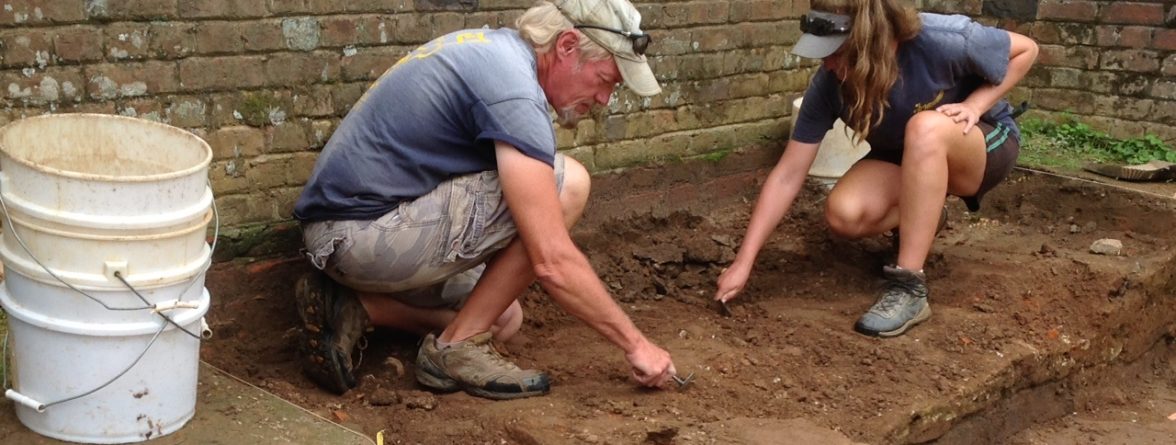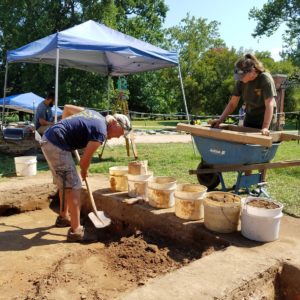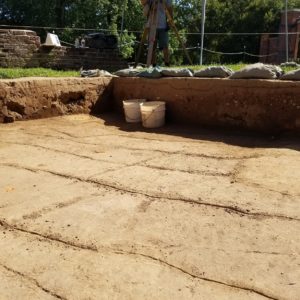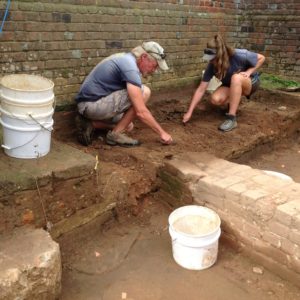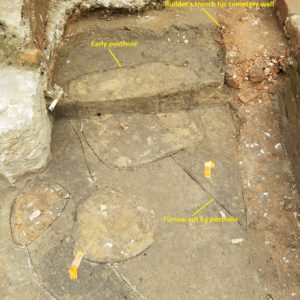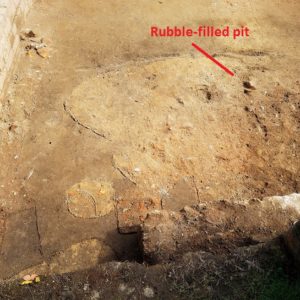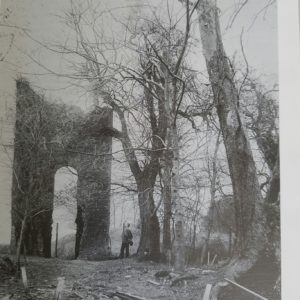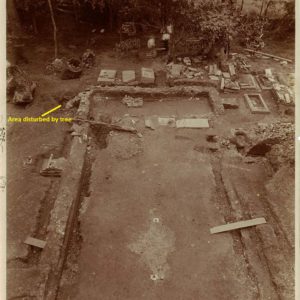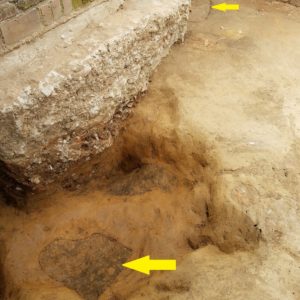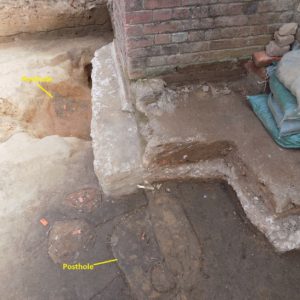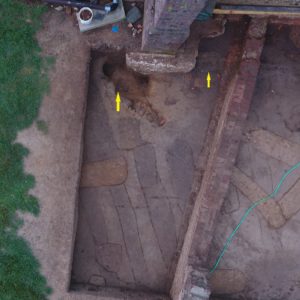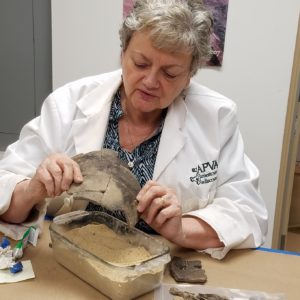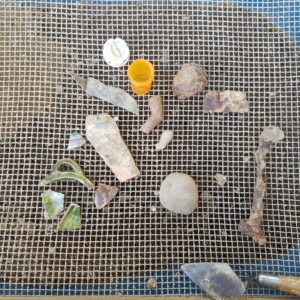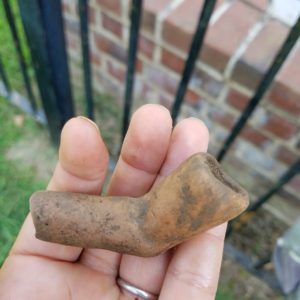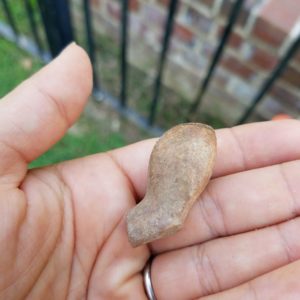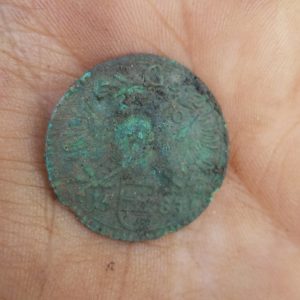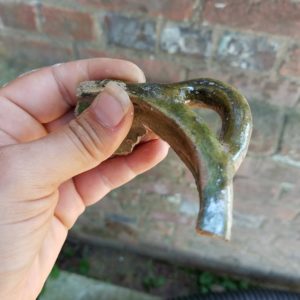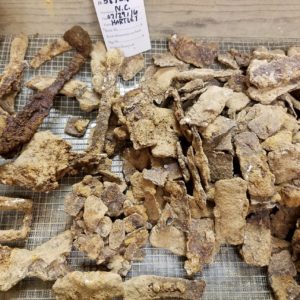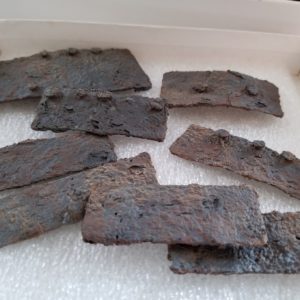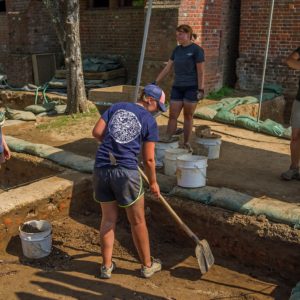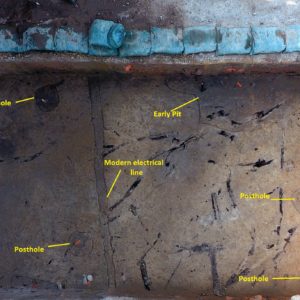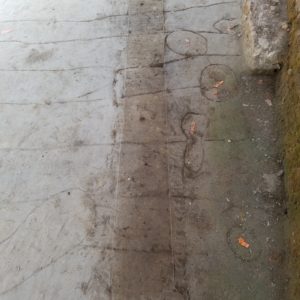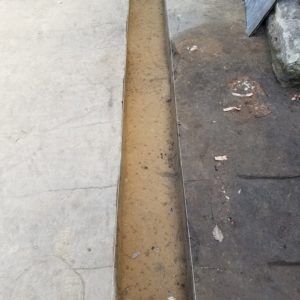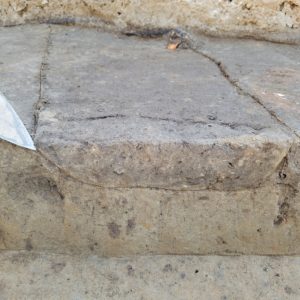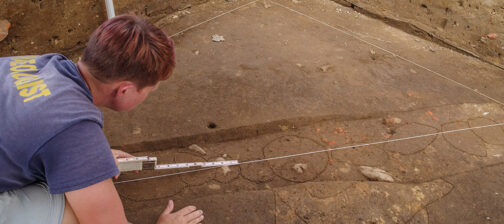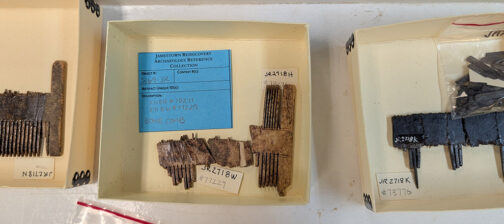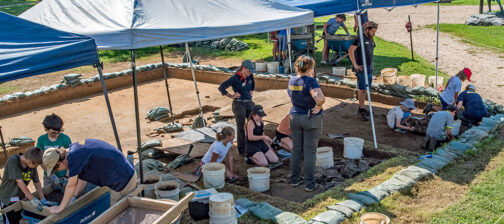As is often the case, the most compelling features surface after our annual summer field school, and students and interns have departed. This year was no exception, with the discovery of several important features dating to the early 17th century. In August, archaeologists expanded the 2016 excavation site, and as units to the east were opened, a square posthole was identified that seems to align with the east wall of James Fort several yards away. This is the first evidence of a structure in the area that predates the 1617 church. To the west, archaeologists discovered the south end of a small pit containing a large concentration of early 17th century material, which appears to relate to a fort-expansion period structure. Finally, archaeologists excavated a test trench through four planting furrows that the field school students discovered.
“Weekend warriors” Lee McBee, Kelsey Watson, and Chuck Durfor excavated two units east of the Ambler-Lee cemetery wall. They identified more planting furrows, a grave, and a pit full of archaeological rubble from the early 20th century excavations of the former churches. They also discovered one posthole, approximately 1½’ square, which was characteristic of holes dug for other early James Fort post-in-ground structures. The fill contained mottled orange and tan clay mixed with dark brown topsoil, and no artifacts. The circular-shaped post mold was filled with a mix of loam and ash. Indicating it was dug post 1607, it sealed two planting furrows.
No matching post holes were found to the north, and it was thought that post holes to the south would probably have been demolished by reoccurring church construction, which began in 1617 and ended in 1906. Despite this, Director of Archaeology Dr. Bill Kelso sent the crew west, in the hopes that the 4’ x 10’ unit directly next to the Memorial Church wall might reveal a portion of the next post. No post holes were uncovered, but an undocumented archaeological test next to the church’s exterior north wall was discovered! Dug in the 1970s or 1980s, artifacts from the test included bits of plastic and an old film wrapper.
With no postholes to the west, the team re-examined the brick rubble-filled pit to the east for evidence of a post hole. In 1901, founder Mary Jeffery Galt recorded that there was “a large sycamore tree growing partly in the northeast corner of the chancel, one root of which extended across the chancel and the minister’s and Knight’s tombs.” When the tree was removed, the pit was filled with Galt’s archaeological till. Rediscovery archaeologists removed the rubble, and despite the pit’s depth of approximately 2’, the very bottom of a 17th-century posthole was found. It is hoped that future excavations to the east and inside the memorial church will reveal more of this structure, which likely dates between 1608, when the palisade expanded, and 1617, when the church was relocated in this site.
As area excavations to the west progressed toward the 1607 east palisade wall of James Fort, the crew noticed a distinct change in the material culture in the overburden. The layers contained less brick rubble and many early 17th century artifacts, including a large sherd of Spanish olive jar, a Venetian glass Nueva Cadiz trade bead, and two clay tobacco pipe bowls. Handmade of local clay, one pipe is covered with its maker’s fingerprints, which may be those of pipe maker Robert Cotton who arrived in 1608. The other pipe, mold made of white ball clay, was manufactured in England around 1610. Among the small metal finds recovered from the area are a copper alloy Krauwinckel jetton and a Groningen token dated 1583. Also uncovered are 73 sherds of a contact period Native American pot are among the finds. These have been mended to form more than three-fourths of the original shell-tempered, smooth surfaced vessel with notched rim. Another significant ceramic item is a small lead glazed Surrey-Hampshire Border ware cheese-making strainer, which indicates the presence of English women, and also of the cattle that first arrived first in 1611.
Finally, a remarkable cache of iron artifacts appeared in the test unit directly adjacent to the palisade. Among the items recovered are a sword pommel counterweight and a stock lock tumbler. Most of the iron, however, consists of numerous brigandine armor plates. These narrow, rectangular-shaped plates with rivets once lined the inside of a cloth garment. All of these artifacts came from the northern limits of a small pit that may be an early fort-period cellar, and four nearby postholes seem to be associated. Rediscovery archaeologists plan to investigate this intriguing structure during the 2017 season.
Before finishing the area near the church foundations, archaeologists placed a 10’ x 1’ x 8” test trench through four planting furrows in order to get profiles. The test revealed only the bottom two inches of each furrow, and that they were filled very early because they contained only prehistoric artifacts. For video footage of this test trench and the furrow profiles, please check out our August 2016 dig update video!
related images
- Lee McBee and Kelsey Watson expand the site east of the Ambler-Lee cemetery wall.
- More planting furrows outlined. These relate to farming outside 1607 James Fort’s east palisade wall.
- McBee and Watson expanding the site to the south to search for postholes associated with the one found in June.
- A view of an early posthole. This post postdates the area’s use for farming in 1607, but predates its use as a churchyard ca. 1617. The post is believed to be part of a fort-period structure in James Fort’s addition
- Brick rubble filling a pit up next to the church’s northeast buttress. The pit is likely related to the removal of a large tree at the corner of the church during excavations in 1901. After the tree was removed, brick rubble from the excavations was used to fill the hole
- Many trees grew amidst the foundations of the church ruins in the late 19th century.
- The brick rubble-filled pit appears in this 1901 photograph of the church foundations following the removal of the huge tree at corner of the church chancel.
- After removal of the brick rubble filling the hole, there were the remains of two features which had been disturbed by the tree stump. One appeared to possibly be a match for the posthole found to the west.
- Two matching posts as viewed from the west looking east.
- Drone image of the site to the east of the cemetery wall. Planting furrows and the two matching postholes are scored
- Curator Merry Outlaw mends several large fragments of a Roanoke Simple plain pot found near 1607 James Fort’s east palisade wall.
- Early 17th-century artifacts from the area of the site directly along the 1607 James Fort wall. Olive jar fragment, delft drug jar fragment, copper jetton, Nueva Cadiz bead (in the pill container), flint nodule, sword pommel weight, tobacco pipes and Borderware strainer handle.
- Locally produced tobacco pipe. May have been manufactured by 1608 pipe maker Robert Cotton.
- European tobacco pipe bowl dated ca. 1610.
- A copper token issued at Groningen, northern Netherlands. If you look closely, you can see the date toward the bottom of the token: 1583.
- The handle for a Borderware colander or strainer. Likely used in the manufacture of cheese
- A tray full of some of the iron found in the test units excavated just east of James Fort’s east palisade wall. Much of the iron likely originated from a small pit identified in that unit.
- Brigandine plates found near the fort’s east wall following conservation by Dan Gamble.
- Interns work to remove the overburden from the units close to 1607 James Fort’s east palisade wall.
- An overall of the portion of the small pit and four postholes discovered up next to the east palisade wall of 1607 James Fort. The dark scars that you see are roots from a tree that once stood near here.
- The 10ft by 1ft test trench laid out through the four planting furrows
- Following excavation of the test trench through the planting furrows.
- Profile for one of the planting furrow trenches


